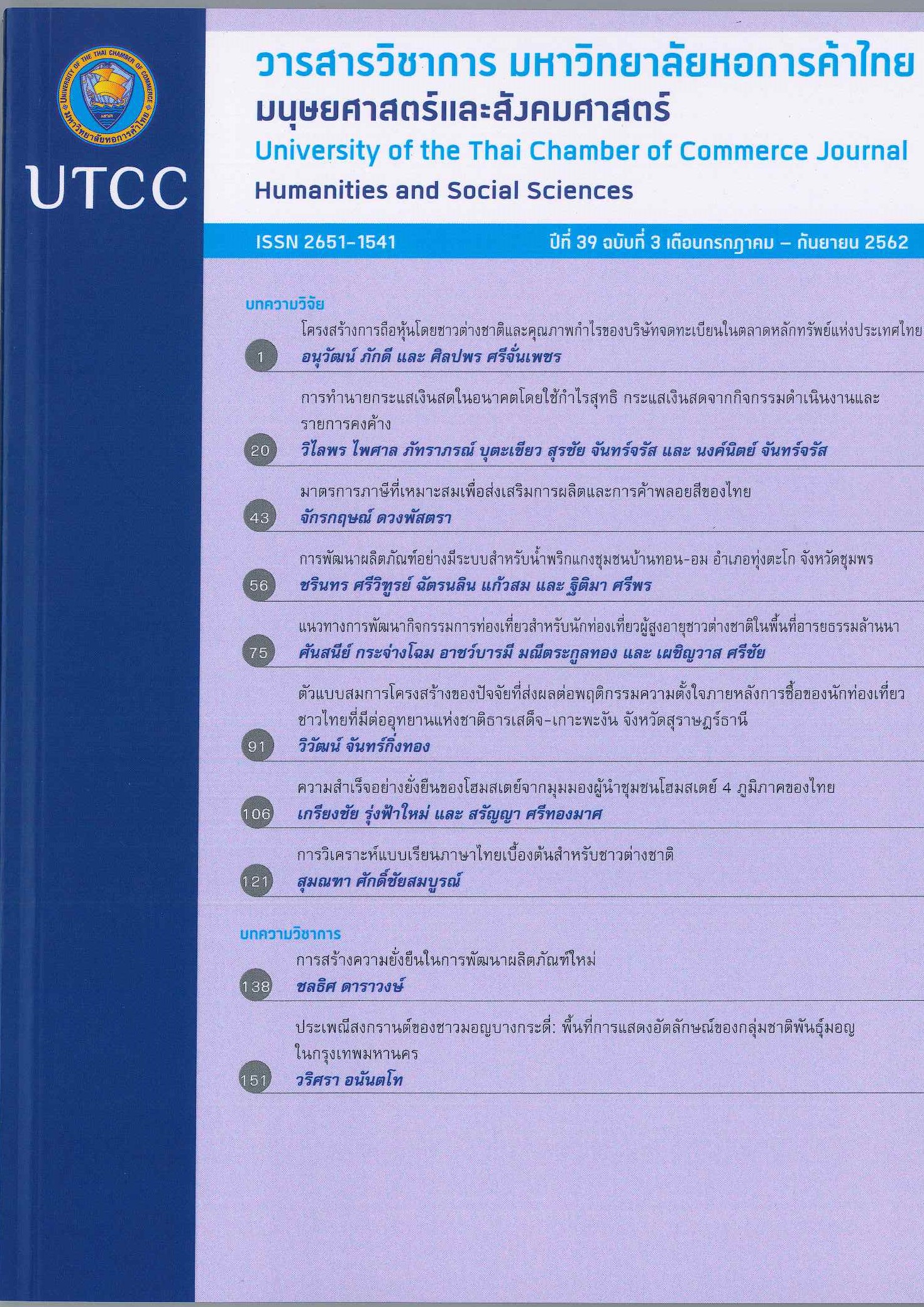Appropriate Tax Measures to Promote the Production and Trade of Colored Stones in Thailand
Main Article Content
Abstract
Various global leading countries of gems production and trade have used tax measures to promote the development of gems industry. The objectives of the research are to collect information of tax burden, strengthes, weaknesses, opportunities, and threats of tax measures imposed on Thai colored stone producers and traders, and propose appropriate tax measures for Thai colored stones producers and traders by using qualitative and quantitative methods. The research suggested government to maintain the removal of import duties and value added tax imposed on importing and selling rought and polished colored stone as well as increase public relation activities to enable entreneurs know how to effectively utilize such tax privileges. In addition, the government should replace the current tax collection practices on corporate income tax and personal income by introducing lump sum tax collection based on revenue earned from colored stone trade. The change in such income tax collection measure would equip Thai government to expand tax base, reduce the usage of general discretion of individual officials in evaluating collectable tax on colored stone tade, and enable entrepreneurs to accurately estimate tax expense.
Article Details
ลิขสิทธิ์ของบทความ
ผลงานที่ได้รับการตีพิมพ์ถือเป็นลิขสิทธิ์ของมหาวิทยาลัยหอการค้าไทย ห้ามมิให้นำเนื้อหา ทัศนะ หรือข้อคิดเห็นใด ๆ ของผลงานไปทำซ้ำ ดัดแปลง หรือเผยแพร่ ไม่ว่าทั้งหมดหรือบางส่วนโดยไม่ได้รับอนุญาตเป็นลายลักษณ์อักษรจากมหาวิทยาลัยหอการค้าไทยก่อน
References
จักรกฤษณ์ ดวงพัสตรา. (2559). รายงานผลการศึกษาโอกาสและความเป็นไปได้ในการพัฒนาไทยเป็นศูนย์กลางการค้าพลอยสีของโลก. กรุงเทพฯ: สำนักงานคณะกรรมการวิจัยแห่งชาติ.
สถาบันวิจัยและพัฒนาอัญมณีและเครื่องประดับแห่งชาติ. (2557). ยุทธศาสตร์และแผนปฏิบัติการการพัฒนาอุตสาหกรรมอัญมณีและเครื่องประดับไทย ปี 2557-2560. กรุงเทพฯ: ผู้แต่ง.
สำนักงานเศรษฐกิจการคลัง. (2554). รายงานผลการวิจัยการศึกษาผลของภาษีมูลค่าเพิ่มต่อการสร้างความเป็นธรรมในการกระจายรายได้และเศรษฐกิจของประเทศไทย. กรุงเทพฯ: ผู้แต่ง.
สำนักงานเศรษฐกิจการคลัง. (2557). รายงานผลการวิจัยการศึกษาแนวทางการปรับปรุงระบบภาษีเงินได้หัก ณ ที่จ่าย เพื่อเพิ่มขีดความสามารถในการแข่งขันและรองรับการเข้าสู่การเป็นประชาคมเศรษฐกิจอาเซียน. กรุงเทพฯ: ผู้แต่ง.
Antwerp World Diamond Center. (2016). The carat tax explained. Retrived March 29, 2018, from https://www.awdc.be/en/carat-tax-explained
Boyette, G., & Hauser, M. (2012). International taxation handbook. Delhi, India: College Publishing House.
Dome. T. (1998). Adam Smith’s theory of tax incidence: An interpretation of his natural – price system. Cambridge Journal of Economics, 22(1), 79-89.
Even-Zohar, C. (2015). Taxing the Antwerp diamond industry into prosperity. IDEX Magazine, 301, 110-116.
Juris, K. (2017). Law design and compliance management for a viable company tax base. Jounal of Australian Taxation, 19(3), 45-50.
Hedau, A. (2018). A review of canons of taxation: India’s perspective. Asian Journal of Research in Social Sciences and Humanities, 8(2), 41-53.
Kemmeren, E. (2018). A global framework for capital gains taxes. Intertax, 46(4), 268-277.
Littlewood, M. (2010). Hong Kong tax system: Its history, its future and the lessons it holds for the rest of the world. Hong Hong Law Journal, 40(1), 65-84.
Rosen, H. (2005). Public finance. Boston, MA: McGraw-Hill.
Tanzi, V. (2001). Tax policy for developing countries. Washington, DC: International Monetary Fund.


